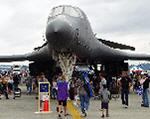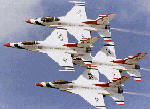
|
Description
| Manufacturer: | ||
| Base model: | Mosquito 166 | |
| Designation: | Mosquito | |
| Version: | 166 | |
| Basic role: | Hang Glider | |
Specifications
| Not Yet Available |
Examples of this type may be found at
| Museum | City | State |
| New England Air Museum | Windsor Locks | Connecticut |
Recent comments by our visitors
| Richard Cobb Blacksburg, VA | The Mosquito is a 1979 era bowsprit glider, which means it has no cross bar. Cables extending from a long nose back to the leading edges serve the purpose that the crossbar usually does.
This is an extremely strong glider as it has double the number of cables of a normal glider. For example, there are two lower side wires on each side - one running from the control bar corner to near the middle of the leading edge, the other runs to almost the tip. It is a USHGMA certified glider, having been built only a year or two after the glider testing and certifying program had been initiated. The cables running to the the ends of the leading edges are relatively tight, the cables that attach to the center of the leading edges are slack so that the leading edge can bow upwards under aerodynamic loading. This allows the leading edge to very closely match the washout on the trailing edge and greatly increase the efficiency of the wing. Conversely, the leading edge can also briefly deflect downwards in turbulence, serving to reduce the turbulent loads. It was approximately 10-30 square feet smaller for the weight range than other gliders at the time, and had a much higher aspect ratio. The weight range for the 166 (actually 163 sq ft) was up to 210 lbs - most other gliders of that weight range at the time ranged from 175 to over 200 sq ft. It flew relatively fast and had an excellent glide ratio - my own experience found it to be comparable to double surface hang gliders of the time. But it only had one really efficient flying speed - minimum sink rate was high, and flying much faster than the best glide airspeed tended to significantly degrade the glide. The bowsprit also caused it to be nose heavy, making it more difficult to land. Probably the most endearing feature was the ease of handling. Cables from the tip of the bowsprit were attached to vertical "trunc-tips" via pulleys near the wing tips. The shifting of the keel sideways in roll also caused the cables to operate the trunc-tips. I used to be mystified at listening to other pilots talk about how worn out they had been from the rough air - I would have basically been flying with fingertip control in the same conditions. Later, when I had been flying more modern gliders I tried the Mosquito out again - the control pressures were so light I found it nearly impossible to fly! I had to use just 2 fingers on each hand to grip the control bar in order to regain enough control that I could land it! 03/06/2001 @ 17:00 [ref: 1776] |
Recent photos uploaded by our visitors





